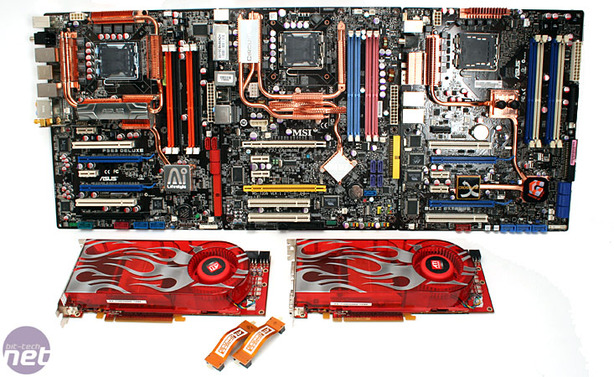The Width of Red and Blue
Being the inquisitive individuals we are here at bit-tech, we decided to try and provide our awesome readers with an answer to the ageing question about PCI-Express bandwidth.Actually, it was between one of our many congregations around someone's PC at work, watching the latest amusing Internet video and stuffing our faces with tea and confectionery, that the idea shot out into the open and was promptly skewered to the calender, like the donkey getting its tail back from a six year old.
Our office shenanigans aside, I'm sure you've read the latest rumours about RV670 making their way around our beloved Internet. They suggest that RV670 might be the hottest thing since sliced bread, and you are therefore contemplating your next upgrade.
With all due respect to our good friends at AMD, the Radeon HD 2900 XT's uptake isn't particularly strong based on statistics from programs like 3DMark and Steam. However, during chats with AMD, the company is insistent that it is selling everything it makes - either it's not making all that many chips, or the opt-in surveys aren't telling the whole story.
Intel being the flavour of the uh... last 15 months with the enthusiast crowd in love with Conroe and are expected to fall in love with the Cornish tourism killer that's also known as Penryn, as its launch is within touching distance now. Because of this it might be a good idea to test CrossFire on various Intel platforms, right?
First we had the Intel 975X, then DFI released a board based on RD600, ATI's last Intel chipset, at the beginning of the year - both of which had two PCI-Express x8 lanes for multi-GPU, but it wasn't until X38 launched (officially just a few days ago) that we have the a pair of full-bandwidth PCI-Express x16 slots for ATI CrossFire on an Intel platform. Of course, P965 with its unbalanced x16 and x4 has been around for a while longer, but that's no good because it's limited by the x4 slot that's routed via the southbridge... at least that's what you'd think right? Or is there more than enough bandwidth anyway and the whole issue is completely blown out of proportion by our friends in marketing?
Does the extra bandwidth really matter?

We whipped up three Intel systems, comparing identically where possible - keeping the consistent use of DDR3 and two ATI Radeon HD 2900 XT 512MB cards throughout the benchmarking sessions. AMD's ATI Radeon HD 2900 XT is the fastest card AMD currently makes, so it will load the PCI-Express bus to its maximum giving us the largest possible difference as we reduce the bandwidth available from dual x16, to dual x8 to finally an unbalanced x16 by x4.
It's worth noting that all our tests were conducted under first-generation PCI-Express specifications, and not the second generation since there are no Gen-2.0 cards currently available, and if we find that two x16s aren't enough then you can assume that Gen-2.0 will do better again. We ran everything with 0AA, 0AF to get the systems throwing out as many frames as possible, rather than having the cards work internally much harder.

MSI MPG Velox 100R Chassis Review
October 14 2021 | 15:04









Want to comment? Please log in.